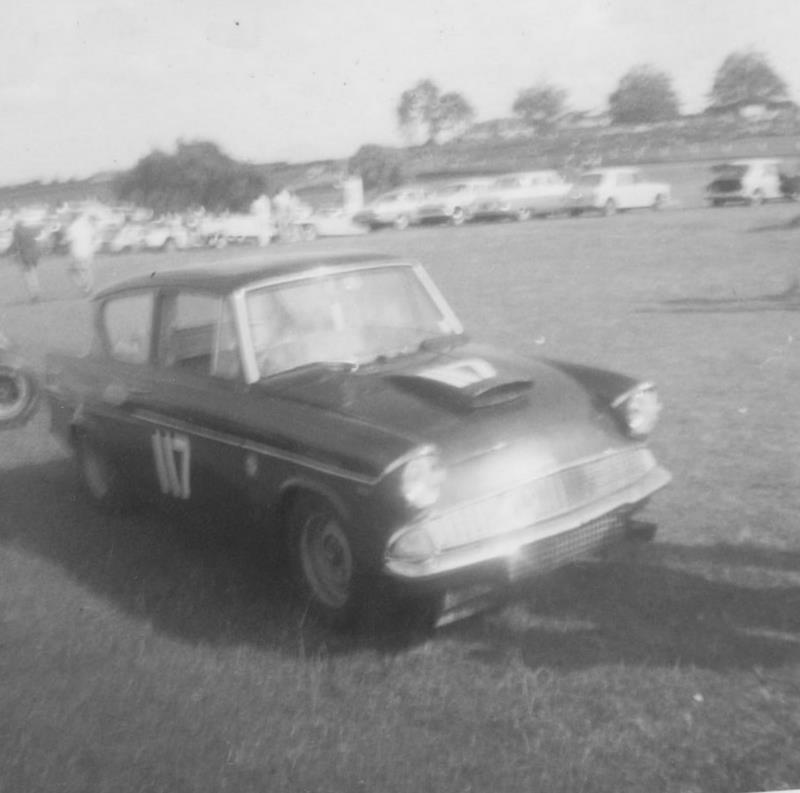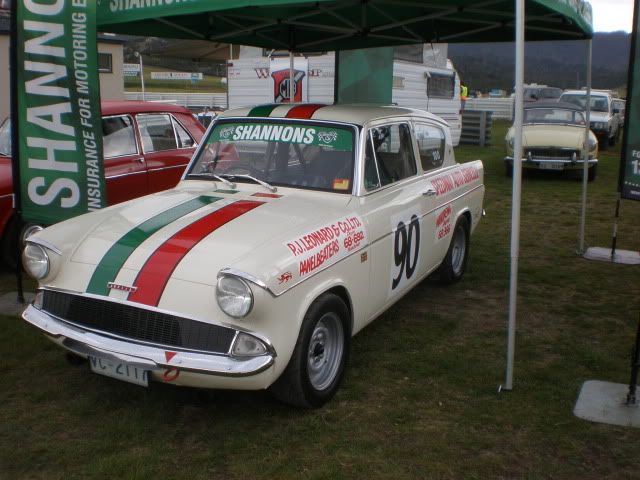Heres another Anglia photo,once again not very good ,I have been looking everywhere for a photo of The John Riley Anglia V8 Olds .I have even asked Brett his son ,sorry but between us this is the best I can do, ( Thanks Brett)

Heres another Anglia photo,once again not very good ,I have been looking everywhere for a photo of The John Riley Anglia V8 Olds .I have even asked Brett his son ,sorry but between us this is the best I can do, ( Thanks Brett)

And John himself ,apparently according to Brett the Anglia was not that loved by John,some time in the future as time allows I intend to write a bit more about it
The Goodwin Anglia
And a few more.

"Goody" now there's a thread. Neat guy.
Bob, thanks for posting this photo. Its the first photo I've ever seen of this car.
NZ Hot Rod mag did a feature on John and his career to that point in 1971. Of the Anglia, the article said: "That same year (1967) John campaigned a beautifully turned out Candy Apple Anglia in the allcomer saloon car races. It was powered by a light weight 3.5 litre Oldsmobile V8 engine, and on paper it looked like a championship contender. And John had planned it that way.
""Rod Coppins was going to put it (the Olds) in something, but he decided not to go ahead with it (and co-raced the ex-Fahey fastback Twin Cam Anglia with John Ward instead) so i bought the engine and a Borg Warner gearbox off him and shopped around for an Anglia to build up. We fitted everything up OK, but we could never ever get the motor to go properly. It threw oil everywhere. It just wouldn't run on eight. We had all sorts of specialists working on it, but it would never run on the elusive eight. It might do it for half a lap, then it would drop to seven, and then onto six. It was never reliable enough to show its true potential. It was very frustrating considering we'd spent so much money on the damn thing..... It did go very well at the first meeting at Renwick (November 1966) but it only lasted two or three laps before it started running on seven. For those few laps I was quite pleased with it.
""I didn't enjoy the car at all. We were working on it every night, every weekend, and every race meeting. And it must have been quite a drain on Shells oil, 'cause it threw out more than it used""
great pic 2 more Angleboxs, in post 83 what class are these cars ? that looks like a Anglia estate
Yes, the potential was certainly there. In theory, it was a great idea. I'd love to know why they never did manage to get it to run correctly.
OK I'm guessing and can offer this as a theory only. Those were relatively early days for alloy engines and porosity was an ongoing, huge problem. The alloys back then were so full of holes they wouldn't keep the water in the right places, same with the oil.
Whether that was the problem with the GM engine I can only speculate, but it certainly had issues with the mating surfaces for gaskets and oil seals.Suspect this was partly due to the greater expansino rate of alloy compared wtih iron.
In the end GM sold it to Rover who re-engineered it with particular focus on the gasket surfaces and oil seals (they were still modifying it when the SD1 series came out in 1976.) It has found widespread use in English cars, often replacing 4 and 6 cylinder engines and it could well have weighed less than the Anglebox 4 cylinder it replaced - the V8 weighed 144kgs.
It also found its way into the Leyland P76 as a 4.4 litre version.
I have seen a few racing Anglias in my day but the Riley one always impressed me. From the outside it looked like a great road car a real sleeper. Its just a pity it didnt impress as much on the track.
Thanks Brett for sharing this
Paul Kirk on here is / was the man on these in those early days and in turn I would respect his opinion and what he says , but going back to our own involvement in those final years of the All comers I did look more than seriously at putting one of those engines into a Anglia and putting the radiator in the rear and ducting air out through the boot lid ,David Vizard did the same with a Anglia with a conventional engine later on ,we actually discussed the concept and idea on his last visit to NZ and as I suspected if the ducting was done properly you would create down force ,a fact David verified to me ,in fact there was a bigger gain to be had than I anticipated .The other benefits were we could get a decent sized radiator in the rear and I guess the front end shape we had in mind would have resembled the Fordina,but back to the engine ,I had a friend Evan Parsons who at that time was working in the states and going to a lot of the racing etc ,he did a bit of chasing around for me to get a engine and send it back and find out information on modifications etc and he came up with a lot of info ,and drawings in particular which involved making up and fitting a thick Alloy plate on the bottom of the block,as Repco did later and further strengthening the block at the top by using the inlet manifold flanges ,we intended to use some 45mm Webers on a cross-over type inlet manifold ,I already had two pairs of them and even though they were expensive they were still more affordable than the IDA option ,anyway I considered the IDA too big for the application .
There was actually quite a lot of bits available for those engines over there at that time at a sensible cost and I felt that a reasonable power output would have been possible with still keeping reliability,I am still positive with the block stiffening to keep everything located and stable with decent head gaskets it would have been successful ,there was nothing that was not available back then that we have not used in later times,we had worked with the old venerable Climax engines back then so were well versed with the importance of clearances etc in Alloy engines ,again I think it was just another of those what if scenarios that life is full off ,but the rules changed and it never happened,I don't think anyone at that time had looked into or had done the block strengthening etc
Thanks guys. I always assumed the issue with the Olds motor in the Anglia was that the block was warped. But I've never read anything to confirm this. In the same NZ Hot Rod article/interview, he talks about the larger 4.5 litre Olds motor he bought off Neil Allen to fit into his Lotus. Here he identifies that the block was warped. So if the same was the case with the motor in the Anglia, I assume he would have mentioned this in the article. But perhaps it was just missed from the article.
Out of interest Bob, how were you able to improve downforce by ducting air into a trunk mounted radiator? Single seaters and sports cars from the mid '60s with front mounted radiators had a relief hole(s) cut in the upper bodywork behind the radiator to allow air exiting out the back of the radiator to be released. I think Bruce McLaren was one of the first to discover this when he cut the upper bodywork on one of his cars to try and relieve it of heavy front lift at speed. I think this may have helped front downforce also? Is this how it would have worked with a rear mounted radiator also?
Trevor Crowe seemed to have all these problems solved with the very same type of Olds V8 that he used very successfully in the two Starlet V8s.
John Harcourt also did a lot of work with these engines (also manifolds, cradles) during the 1980's, he raced a quick Mk1 Escort Olds V8 in the mid 1980's and then later took the ex Crowe & Freeth Starlet to an OSCA championship.
Yes by picking the air up through the radiator and ducting it out through a hole in the boot lid ,must see some time if I can find the Vizard article when he did it some time later ,some one else on here might have it as well !,one thing I didn;t add last night is don't forget that F85 Olds engine and bits nearly got used by be me in a Escort seven years later ,I still believe it was a good option that would have worked ,none of the people who came along later had anything that was not avaliable to us in 66/67
spot at MCM Eastern Creek
Neil Doyle 1967,
This is the photo from the David Vizard article ,that shows how he used the airflow from under the car ,we were going to do something similar ,but the radiator would have been in the boot at the end of the under floor ducting ,keep in context as well ,this was our intention in 66/67 ,it was a few years after this before David did it ,I actually thought I had somewhere how much theoretical pressure he gained doing this ,but maybe he just mentioned it in conversation
Jim Richards was Guest of Honor at Baskerville Historic meeting 14-16 Oct 2011.
The owner of the Don Elliot replica Anglia Super had it sign written up with some of
Jims old Anglia sponsors . Unbeknowns to Jim it was cordonned off in a VIP area at
Hobart Airport and used to ferry him to the Casino. His eyes lit up when he was led
to it on arrival. If it ever is on the market he wants it.
I mentioned the Roaring site to him and he was very interested .

Last edited by Ellis; 10-17-2011 at 01:29 AM.